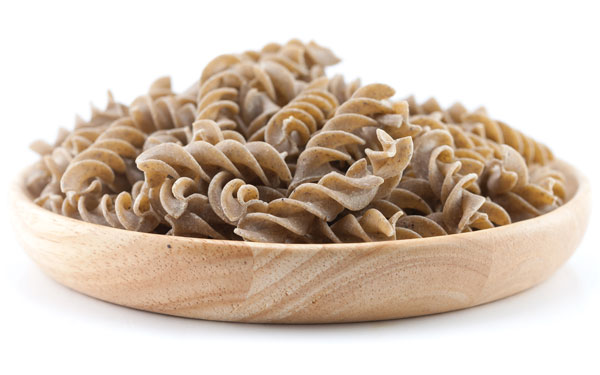Cricket pasta – the edible insect revolution is served
- Like
- Digg
- Del
- Tumblr
- VKontakte
- Buffer
- Love This
- Odnoklassniki
- Meneame
- Blogger
- Amazon
- Yahoo Mail
- Gmail
- AOL
- Newsvine
- HackerNews
- Evernote
- MySpace
- Mail.ru
- Viadeo
- Line
- Comments
- Yummly
- SMS
- Viber
- Telegram
- Subscribe
- Skype
- Facebook Messenger
- Kakao
- LiveJournal
- Yammer
- Edgar
- Fintel
- Mix
- Instapaper
- Copy Link
Posted: 22 February 2016 | Karen Li, Online Marketing Specialist, Bugsolutely | 1 comment
For the first time, the most common food in the world contains… insects. With 20% cricket flour, Cricket Pasta has a number of nutritional benefits, and it is set to start a completely new segment in the pasta business.


Only a couple of years ago, nobody would have thought of a pasta containing insects. Insect flour, to be precise. But in the last few months an entire industry developing food products containing insects has appeared, and seems to be thriving vigorously. Cricket Pasta has recently joined this group of unexpected, newly-born bug delicatessens.
Why cricket flour?
When someone mentions protein, you think of beef. Someone mentions omega-3, salmon is in your mind. When someone mentions iron, it is likely spinach will be named. Cricket flour contains all these nutritional benefits, and more. Crickets have about twice as much protein as cows, and five times more magnesium for about half the calories. But just as important as the nutritional characteristics, cricket flour tastes good. The taste is similar to roasted nuts, and it goes perfectly with wheat flour, creating a pasta with a distinct and satisfying flavour.
For these reasons and more, in 2015 Massimo Reverberi founded the Bangkok-based company Bugsolutely (www.bugsolutely.com), which just launched their Cricket Pasta. “The entomophagy industry is based on a simple idea: the entire world eat insects, except western countries,” explained Reverberi. “We are the only people that think crickets are completely different from something like a shrimp, when in fact they are very similar. We eat animals with an obvious disgusting appearance, like an oyster or a snail, but because of our education and subconscious, fuelled by movies and fairy tales, ants or crickets as food gives us that ‘gag’ reflex.”
Reverberi added: “Luckily, market researchers indicate that about half of the western population is willing to overcome this cultural obstacle and try something new. We think that pasta will be a great way to reduce the dissonance for their first time eating bugs. The wide press coverage recently is also helping to correct the prejudices a lot.”
Creating cricket pasta
Bugsolutely started with testing different mixes of ingredients and first created a gluten-free pasta. “But gluten-free, despite being popular these days, does not taste as good as a gluten pasta,” in Reverberi’s opinion. “And we do not want people to think that it is because of the cricket flour. It is the consumer’s first contact with this new ingredient, and it has to be perfect. Our current generation of pasta, with 80% wheat flour imported from Australia and 20% cricket flour produced in Thailand, is delicious.”
Compared to other edible insect products on the market, 20% cricket flour is a high percentage. At the moment, producing the cricket flour is limited, taking place in small scale factories in Canada, USA and Thailand. In the future, processes will be optimised and prices will fall rapidly. The cricket flour used for Bugsolutely’s Cricket Pasta comes from a HACCP certified and FDA approved manufacturer and comes in 5kg vacuum sealed black packages, as light can affect the protein. The pasta is made in a GMP certified artisanal factory directed by managers with international experience, and it is then sealed in 350g transparent plastic bags, then inserted in the carton package.
Thai FDA has approved it, and nutritional fact analysis has highlighted the unique quality of this food, and in particular the protein content. The complete lab test results are available at www.bugsolutely.com/wp-content/uploads/2015/12/nutrition-facts-complete-USA.jpg.
Producing cricket flour
In the future, Bugsolutely is planning to start its own production of cricket flour. This would allow a more strict control over the taste of their Cricket Pasta. For this reason, a collaboration with the Food Technology Department of a Thai University has been initiated, as well as the application to the Thai government office for special project support has been requested. Currently, there is limited research regarding the production of cricket flour. The few productions in place just use simple drying ovens designed for different foods, like vegetables or fruit, but are not optimised for insect drying. Temperature levels can change the roast nuances and the distinctive brown colour of the flour, making it lighter or darker.
When using the grinders the oil content of crickets can also make the life of milling machines quite hard, because they are not designed for crickets. The cricket flour for pasta production, and also for baking, needs to be as fine as wheat flour (ideally, between 200 and 400 microns). In addition, the taste of the cricket flour depends on what the crickets eat. Crickets are omnivores, but a diet based on vegetables is acceptable to them. Different feed choices means slightly different cricket flour flavours.
Thinking about sustainability
The global population will grow to nine billion people by 2050, according to most predictions. The Food and Agriculture Organization of the United Nations has stated that insects are the key to a sustainable and nutritious food source. Crickets in particular have great advantages in so many areas. They take up far less space than any traditional livestock. They need only 2kg of feed to produce 1kg of protein, which is five times less than a cow. This is important because the feed for the livestock also needs land as well as irrigation, taking up our valuable water resources. Crickets mature in roughly six weeks and can be eaten whole, whereas cows take about fifteen to thirty months and only half of a cow’s final weight can be eaten. It is estimated that crickets are 20% more efficient in producing protein than cows. Livestock is also responsible for 18% of global greenhouse gas emissions.
Joining the revolution
Westerners already eat odd things like cheese mould, snails, and frogs. In Italy there is a cheese containing worms which is supposed to be eaten with the worms intact and still alive. Most people even prefer to eat many types of shellfish while still alive, such as oysters and sea urchins, as they taste better.
There is no reason for edible insect ingredients not to become mainstream in the near future. But what about the regulations? Bugsolutely Cricket Pasta is made with crickets raised for human consumption, and this seems to be the only key requirement for the US FDA. As for the European Union, the parliament has indicated insect-based products as an innovation with a positive effect, and has begun the procedure for them to be approved. Some members of the EU anticipated this: Belgium and The Netherlands released their own regulations, allowing the sale and consumption of the most common edible insect species, including crickets, or Acheta Domestica, to be precise. France and the UK seem to be very flexible, even if they are in a grey area, legally speaking. According to the vast majority of opinions, regulations for import, production and consumption of bugs as food will spread in the western world in a couple of years at the most. Australia and New Zealand are already importing and eating cricket flour products. Bugsolutely is dealing with distributors in all of those countries, as well as Korea, where insects are considered a delicacy.
…and finally enjoying the meal
“Mushroom and cream, this is the verdict of the people who have already tasted Cricket Pasta, the perfect sauce that matches the slightly almond taste from the cricket flour,” affirms Reverberi. “Some recipes are published on our blog, which can be reached from Bugsolutely’s website.” He added: “Because we are in Thailand (the motherland of edible insects), we also had a local chef preparing Cricket Pasta with a Thai sauce, local vegetables, chicken and the ever-present chili. Let me tell you, it was as good as any of the best Italian sauces.”
Reverberi concludes: “Cricket Pasta is raising a lot of curiosity. The pasta world was already changing in the last few years, with the introduction of a number of flours from different vegetables, but clearly a flour made of insects is a surprise for everyone.”
About Bugsolutely
Bugsolutely was founded by Massimo Reverberi. Born in Milan, Reverberi attended the University of Milan, Political Science, obtaining a degree in Business Management. In 1997 he co-founded Prima Pagina, which soon became a major player between marketing agencies in Italy. At the end of 2012 he left the agency and Italy and spent two years exploring business opportunities in South East Asia, mostly in Thailand. He finally found the best one, in Bugsolutely.
Bugsolutely (www.bugsolutely.com) is a business focused on developing, making and exporting foods made from edible insect flours. Founded in 2015 in Bangkok as a Thai limited company, Bugsolutely is right at the core of the new bug business, which is spreading fast in all the western countries, and has gained wide press coverage in the last two years. Bugsolutely products are the result of extensive research into finding the best possible combination for a tasty and healthy food. Bugsolutely’s export strategy to western countries is based on partnerships with international food distributors and on their International online shop. The key product for 2016 is Bugsolutely Cricket Pasta, a mix of durum semolina flour, wheat flour, and cricket flour sourced from selected suppliers that are GMP and HACCP certified. The product is available as fusilli, in a 350g (12.3 Oz) sealed package. Other pasta formats are in the works to be released in the next months.
Bugsolutely and Cricket Pasta are Registered Trademarks in Thailand and are undergoing Trademark registration in a few other parts of the world.
About the author
Karen Li is an Online Marketing Specialist with a great love of food and an astonishing sweet tooth. A truly international second generation citizen, she has spent her time mostly in Hong Kong, New Zealand, Australia and is currently based in Bangkok. Karen’s background is in Hospitality Management and Education, focused mainly in the Food and Beverage industry. She is obviously the go-to foodie in her eclectic group of friends and her curiosities are now in the innovative and rapidly growing edible insect industry.










It’s wonderful that you are getting thoughts from
this paragraph as well as from our discussion made here.